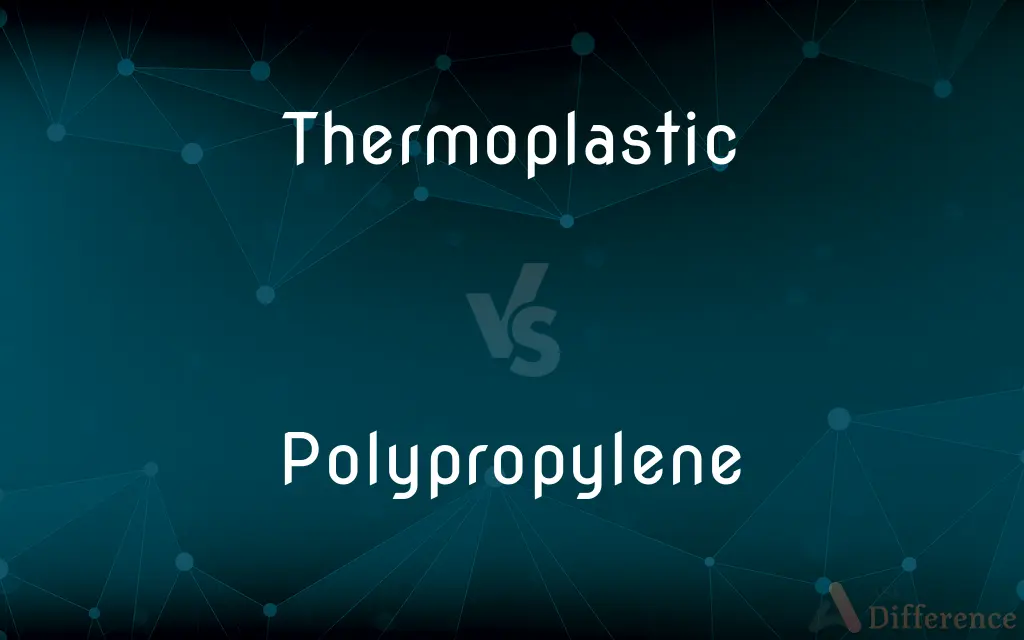Thermoplastic vs. Polypropylene — What's the Difference?
Edited by Tayyaba Rehman — By Urooj Arif — Updated on April 17, 2024
Thermoplastics are a broad category of plastics that become moldable upon heating, whereas polypropylene is a specific type of thermoplastic known for its resistance and versatility.

Difference Between Thermoplastic and Polypropylene
Table of Contents
ADVERTISEMENT
Key Differences
Thermoplastics encompass a wide range of polymers that soften when heated and harden when cooled, allowing them to be recycled and reshaped. Polypropylene, a type of thermoplastic, is distinguished by its low density and high chemical resistance.
While thermoplastics are valued for their recyclability and versatility in manufacturing, polypropylene is particularly appreciated for its strength and fatigue resistance, making it ideal for products that require repeated bending.
Thermoplastics include materials such as PVC, nylon, and acrylic, each with unique properties and applications. Polypropylene, on the other hand, is frequently used in automotive parts, textiles, and packaging due to its robustness and moldability.
While many thermoplastics are susceptible to UV damage and chemical degradation, polypropylene is notably resistant to both, enhancing its usefulness in outdoor and chemical exposure applications.
Thermoplastics generally offer electrical insulation properties; however, polypropylene is specifically favored in electrical applications for its excellent dielectric properties, including high insulation resistance.
ADVERTISEMENT
Comparison Chart
Definition
Broad class of plastics that are moldable when heated.
A specific type of thermoplastic known for its toughness and chemical resistance.
Density
Varies, generally low to moderate.
Low density, lighter compared to many other plastics.
Chemical Resistance
Generally good, varies by type.
Excellent, resistant to many chemical solvents, bases, and acids.
UV Resistance
Varies, often requires additives for UV stability.
Naturally good, more UV-resistant than many other thermoplastics.
Common Uses
Includes packaging, automotive parts, consumer goods.
Often used in food containers, automotive components, textiles.
Compare with Definitions
Thermoplastic
Often used in everyday items due to ease of manufacturing.
All the kitchen utensils are made of different types of thermoplastics.
Polypropylene
Known for its resistance to fatigue.
The flexible polypropylene chairs withstand frequent use.
Thermoplastic
A plastic material that can be repeatedly melted and remolded.
The manufacturer used thermoplastic for the new phone cases because of its recyclability.
Polypropylene
A polymer used extensively in packaging and labeling.
Polypropylene bags are popular for their strength and durability.
Thermoplastic
Any of various polymers that soften when heated and harden upon cooling.
Thermoplastic resins are preferred for 3D printing applications.
Polypropylene
Has a high melting point compared to many other plastics.
Polypropylene is ideal for microwave-safe containers due to its high melting point.
Thermoplastic
Thermoplastics are known for their ability to be welded.
The pipes were joined using thermoplastic welding techniques.
Polypropylene
Resistant to many chemical solvents.
Polypropylene containers are used for storing laboratory chemicals.
Thermoplastic
Exhibits plasticity over a certain temperature range.
Thermoplastics become moldable above their glass transition temperatures.
Polypropylene
Used in automotive parts due to its toughness.
Polypropylene is used in the car bumper because it absorbs impacts well.
Thermoplastic
A thermoplastic, or thermosoftening plastic, is a plastic polymer material that becomes pliable or moldable at a certain elevated temperature and solidifies upon cooling.Most thermoplastics have a high molecular weight. The polymer chains associate by intermolecular forces, which weaken rapidly with increased temperature, yielding a viscous liquid.
Polypropylene
Polypropylene (PP), also known as polypropene, is a thermoplastic polymer used in a wide variety of applications. It is produced via chain-growth polymerization from the monomer propylene.
Thermoplastic
Becoming soft when heated and hard when cooled.
Polypropylene
A synthetic resin which is a polymer of propylene, used chiefly for films, fibres, or moulding materials
High-impact polypropylene
Polypropylene underwear
Thermoplastic
A thermoplastic resin, such as polystyrene or polyethylene.
Polypropylene
Any of various thermoplastic polymers of propylene. They are hard and tough, and are used to make molded articles and fibers.
Thermoplastic
Softening when heated and hardening when cooled, and thus able to be moulded
Polypropylene
A fabric of fibers made from any of these polymers.
Thermoplastic
A plastic with this property.
Polypropylene
A thermoplastic resin made by the polymerization of propylene, and used for films, fibres, or moulding materials. Also known as polypropene.
Thermoplastic
A material that softens when heated and hardens again when cooled
Polypropylene
A polymer of propylene used as a thermoplastic molding material
Thermoplastic
Having the property of softening or fusing when heated and of hardening and becoming rigid again when cooled;
Thermoplastic materials can be remelted and cooled time after time without undergoing any appreciable chemical change
Common Curiosities
Can polypropylene be used in high-temperature applications?
Polypropylene has a high melting point, making it suitable for some high-temperature applications but not as high as some specialty plastics.
What are the environmental impacts of using thermoplastics?
The production and disposal of thermoplastics can contribute to pollution and waste, though recycling can mitigate some environmental impacts.
What makes polypropylene different from other thermoplastics?
Polypropylene is particularly noted for its stiffness and resistance to chemical solvents, acids, and bases, distinguishing it from other thermoplastics.
Are thermoplastics safe for use in medical devices?
Yes, certain grades of thermoplastics are safe and commonly used in medical devices due to their sterilizability and chemical resistance.
What is the difference in heat resistance between thermoplastics and polypropylene?
Heat resistance varies among thermoplastics; polypropylene offers good heat resistance but not as high as some engineering thermoplastics like polyether ether ketone (PEEK).
How do thermoplastics respond to fire?
Most thermoplastics are flammable to varying degrees; however, flame retardant additives can improve their fire resistance.
How does the cost of polypropylene compare to other plastics?
Polypropylene is generally cost-effective compared to many other plastics, especially considering its durability and versatility.
Is polypropylene considered a sustainable material?
Polypropylene is recyclable, which supports sustainability, but like all plastics, its production and disposal can have environmental drawbacks.
What types of products are most commonly made from polypropylene?
Common products include automotive parts, food containers, textiles, and medical components due to polypropylene's robust properties.
What advancements are being made in thermoplastic technology?
Advances include the development of bio-based thermoplastics, improved recycling techniques, and the formulation of composites for enhanced properties.
How do the electrical properties of thermoplastics compare to those of polypropylene?
While thermoplastics generally have good electrical insulation properties, polypropylene is especially valued in electrical applications for its excellent dielectric strength.
What are some common additives used with thermoplastics?
Additives such as UV stabilizers, flame retardants, and plasticizers are commonly used to enhance the properties of thermoplastics.
Can polypropylene be painted or dyed?
Polypropylene can be difficult to paint or dye due to its non-porous nature and chemical resistance; however, specialized treatments or coatings can be applied.
Are thermoplastics biodegradable?
Most thermoplastics are not biodegradable, but biodegradable versions are being developed to reduce environmental impact.
How does polypropylene behave under mechanical stress?
Polypropylene exhibits excellent toughness and good fatigue resistance, making it suitable for products that undergo repeated mechanical stress.
Share Your Discovery

Previous Comparison
Eskimo vs. Inuit
Next Comparison
Homonym vs. PunAuthor Spotlight
Written by
Urooj ArifUrooj is a skilled content writer at Ask Difference, known for her exceptional ability to simplify complex topics into engaging and informative content. With a passion for research and a flair for clear, concise writing, she consistently delivers articles that resonate with our diverse audience.
Edited by
Tayyaba RehmanTayyaba Rehman is a distinguished writer, currently serving as a primary contributor to askdifference.com. As a researcher in semantics and etymology, Tayyaba's passion for the complexity of languages and their distinctions has found a perfect home on the platform. Tayyaba delves into the intricacies of language, distinguishing between commonly confused words and phrases, thereby providing clarity for readers worldwide.













































